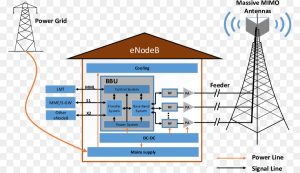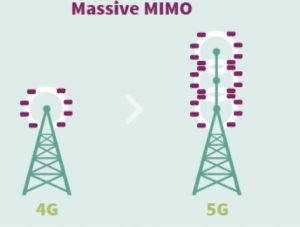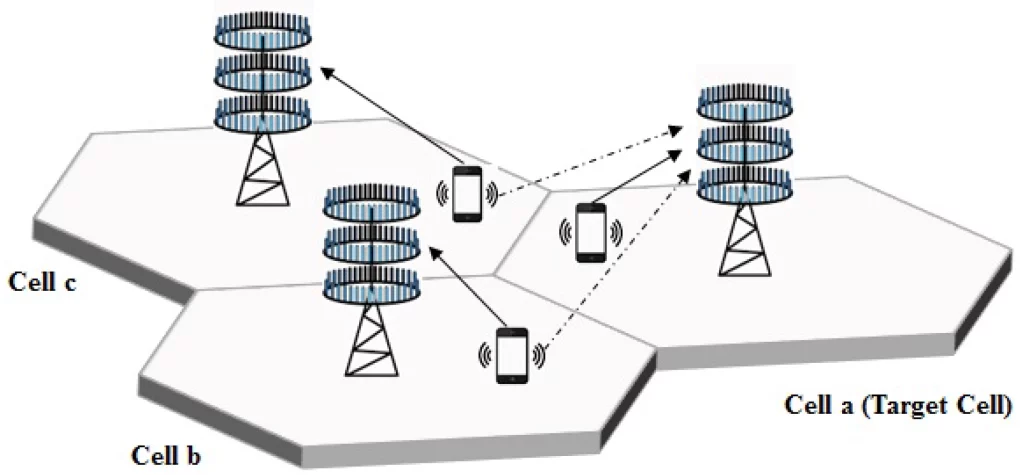The utilization of antenna arrays is vital in the quest to amplify spectral efficiency within wireless communication systems. In massive MIMO arrangements, these arrays are equipped with a multitude of antennas that enable concurrent transmission and reception of signals. The result? A system capacity and spectral efficiency boost like no other.

Uplink massive MIMO systems are enhanced by applying techniques such as precoding and pilot reuse. With precoding, signal manipulation at the transmitter end heightens its quality at the receiver’s end. Meanwhile, pilot reuse enables multiple users to share one pilot sequence; this lowers overhead costs while simultaneously increasing system capacity.
But wait – there’s more! Augmenting performance through increased transmit power and uniform linear array gain can also expand coverage areas for massive MIMO systems. Transmit power determines signal travel distance, while uniform linear array gain ensures equal sensitivity among all antennas across various directions – both factors significantly elevate spectral efficiency levels. It’s no wonder why wireless communication networks can now support more users with faster data rates over longer distances without compromising on quality or reliability!
Exploring the Benefits of Massive MIMO Systems by Increasing Transmit Power and Uniform Linear Array Gain
Contents
- 1 Exploring the Benefits of Massive MIMO Systems by Increasing Transmit Power and Uniform Linear Array Gain
- 2 Spectral Efficiency Analysis for Massive MIMO Cellular Systems: A Detailed Look
- 3 Augmentation in Uplink Massive MIMO Systems: Efficiency Enhancement through Precoding and Pilot Reuse
- 4 Achievable Spectral Efficiency and Area Energy Efficiency of Massive MIMO Technology: Findings of This Work
- 5 Improving Spectral Efficiency in Uplink Massive MIMO Systems: Power Control and Inter-User Interference Allocation
- 6 Trustworthy SIoT Aware Mechanism as an Enabler for Citizen Services in Smart Cities: A Case Study of Massive MIMO Networks
- 7 OFDM, Block-Fading, and mmWave: Exploring Linear Processing Techniques for High Spectral Efficiency in Wireless Communication
The rise of Massive MIMO systems has captivated the attention of many in recent times due to their remarkable capacity for providing high spectral efficiency. To further uplift the performance of these systems, one can augment them by boosting transmit power and uniform linear array gain. This feat is accomplished by employing multiple antennas at both ends, thereby allowing for spatial multiplexing.

In downlink transmission, elevating transmit power results in a higher signal-to-noise ratio (SNR) at the receiving end which leads to improved spectral efficiency. Similarly, in uplink transmission, increasing uniform linear array gain helps ameliorate SNR at the base station resulting in better system performance. These enhancements ultimately culminate into increased data rates and more dependable communication.
Augmenting efficacy in uplink massive MIMO systems can also be achieved through techniques such as precoding and pilot reuse. Precoding requires applying a transformation matrix on transmitted signals that optimizes them for reception at specific antenna elements while pilot reuse involves reusing pilot symbols across different users or cells while ensuring minimal interference between them; both techniques improve energy and spectral efficiency while maintaining low complexity.
By exploiting these techniques along with amplified transmit power and uniform linear array gain, Massive MIMO systems can achieve even greater levels of spectral efficiency than traditional wireless communication technologies like OFDM or block-fading channels . As research continues to explore new ways of optimizing transmission parameters such as equation-based optimization algorithms or machine learning models for beamforming design we can expect even greater gains from this technology without compromising reliability or security concerns associated with SIoT-aware mechanisms that enable citizen services within smart cities infrastructure networks.\n
Spectral Efficiency Analysis for Massive MIMO Cellular Systems: A Detailed Look
The perplexing issue of spectral efficiency analysis in massive MIMO cellular systems cannot be understated. The data rate that can be transmitted within a given time period is directly proportional to the bandwidth. However, with increased bandwidth comes elevated levels of interference and noise, which may have an adverse effect on system performance.
To combat this issue, various approaches such as precoding and pilot reuse have been proposed for uplink massive MIMO systems. Precoding shapes signals before they are sent from base stations (BS) to wireless devices, while pilot reuse allows multiple users to share pilot sequences resulting in reduced overhead and increased network capacity.
Linear processing techniques like uniform linear array gain also play a significant role in improving spectral efficiency. This method involves adding more antennas at BSs to increase coverage area while minimizing interference between adjacent cells resulting in high-quality signal reception overall.
In conclusion, optimizing spectral efficiency entails careful consideration of numerous factors like bandwidth allocation and antenna placement strategies such as augmentation in uplink massive MIMO systems or uniform linear array gain techniques. Continual exploration through simulation studies by researchers will pave the way towards achieving high spectral efficiency standards for next-generation wireless communication networks.
Augmentation in Uplink Massive MIMO Systems: Efficiency Enhancement through Precoding and Pilot Reuse
Optimizing uplink spectral efficiency in Massive MIMO networks can be a daunting task. However, through the clever use of precoding and pilot reuse, one may achieve this elusive goal. Precoding involves manipulating data transmission from User Equipment (UEs) by applying linear transformation before it reaches the base station. This technique enables better management of inter-cell interference, which ultimately leads to improved channel capacity and reduced signal fading.
Pilot reuse is another technique that contributes significantly to increasing system capacity by reusing pilots across multiple UEs. But wait, there’s more! To compute uplink spectral efficiency with precoding and pilot reuse effectively, one must consider both uplink and downlink channels as well as Signal-to-Noise Ratio (SNR) levels at each UE.
Massive MIMO systems are particularly suited for this type of optimization since the achievable rate is proportional to the number of antennas at both the UE and base station sides – mind-boggling stuff!
Recent research has shown how these techniques work together seamlessly to create significant gains in uplink spectral efficiency when implementing joint processing with precoding and pilot reuse. By using these methods to optimize inter-cell interference without relying on increased transmit power or additional frequency bands, researchers have achieved higher data rates while still maintaining high-quality wireless communication between UEs and their respective base stations – now that’s impressive!
Achievable Spectral Efficiency and Area Energy Efficiency of Massive MIMO Technology: Findings of This Work
The cellular network industry has become increasingly enamored with the massive multiple-input and multiple-output (MIMO) technology. This cutting-edge innovation promises to deliver higher data rates while simultaneously minimizing power consumption. Björnson et al.’s study on the achievable spectral efficiency and area energy efficiency of massive MIMO cellular systems proves that adding more antennas to an antenna array can significantly improve spectral efficiency, which is defined as the amount of data transmitted per unit bandwidth.
Yet, there’s a catch. The signal transmission process becomes cluttered with interference from other cells when more antennas are added, presenting a significant issue that must be resolved. Zero-forcing (ZF) precoding comes into play here by reducing inter-cell interference through eliminating unwanted signals before they reach their desired destination – ultimately improving both spectral efficiency and area energy efficiency.
However, Björnson et al.’s research also highlights a crucial trade-off between achieving high spectral efficiency and maintaining energy efficiency: increasing the number of antennas directly leads to higher power consumption for signal processing operations. Therefore, it is imperative to strike an optimal balance between these two metrics when designing efficient massive MIMO systems for cellular networks.
Improving Spectral Efficiency in Uplink Massive MIMO Systems: Power Control and Inter-User Interference Allocation
The perplexing world of uplink massive MIMO systems leaves many scratching their heads, but fear not! There are bursty solutions to improve spectral efficiency. Power control is a technique that dynamically adjusts the transmit power of each user to minimize interference and enhance overall system performance. And if that’s not enough, inter-user interference allocation comes into play by allocating subcarriers to users with high signal-to-interference-plus-noise ratio (SINR), resulting in even greater spatial multiplexing.
But wait, there’s more! Augmentation techniques like precoding and pilot reuse offer an alternative approach to increasing spectral efficiency. Precoding applies a linear transformation pre-transmission over multiple antennas, which improves SINR and reduces inter-user interference. Pilot reuse allows for efficient resource use by reusing pilots from other users while maintaining accurate channel estimation.
Not convinced yet? Well then, let me introduce you to distributed coding schemes – the cherry on top of this complex technological sundae. These schemes contribute significantly towards achieving impressive spectral efficiencies in uplink massive MIMO technology. Spatially distributed coding techniques permit simultaneous transmission from multiple users without causing significant interference or degradation in performance.
In conclusion, combining power control, inter-user interference allocation, augmentation techniques such as precoding and pilot reuse along with spatially distributed coding methods can achieve high spectral efficiency per user in uplink massive MIMO systems; one small step for technology but a giant leap for mankind!
Trustworthy SIoT Aware Mechanism as an Enabler for Citizen Services in Smart Cities: A Case Study of Massive MIMO Networks
The evolution of modern-day living has been irrevocably influenced by the development of Smart Cities. The integration of technology, particularly massive MIMO networks, has played a pivotal role in providing citizen services with unprecedented efficiency and effectiveness. Ateek Ur Rehman’s research on enhancing spectral efficiency (SE) through bandwidth expansion and Bjornson’s analysis for massive MIMO cellular systems have yielded promising outcomes in augmenting communication between base station antennas and user equipment.
One avenue to improve SE is via pilot reuse techniques that allocate resources more judiciously. Multicell coordination can also significantly bolster SE while concurrently minimizing circuit power consumption. Moreover, power control mechanisms decrease inter-user interference allocation errors, leading ultimately to better performance regarding bit error rate (BER).
In addition, comparative studies have demonstrated that there still exists ample room for improvement in SE when juxtaposed against traditional wireless technologies such as OFDM and block-fading channels. However, it must be emphasized that implementing these techniques necessitates dependable SIoT aware mechanisms ensuring the preservation of security and privacy throughout the network infrastructure.
Overall, Massive MIMO networks have substantiated themselves as a game-changer concerning provisioning citizen services within smart cities by proffering improved reliability and connectivity capabilities while preserving high standards of security protocols.
OFDM, Block-Fading, and mmWave: Exploring Linear Processing Techniques for High Spectral Efficiency in Wireless Communication
The perplexing world of wireless communication systems is constantly evolving and incorporating new techniques to achieve high spectral efficiency. OFDM, block-fading, and mmWave are just a few examples of the linear processing methods that have been adopted in the development of 5G technology.
OFDM stands out for its dynamic allocation of subcarriers based on channel conditions, which effectively mitigates inter-user interference. Meanwhile, block-fading breaks down data streams into smaller blocks transmitted over separate channels to combat signal attenuation or interference from other sources.
But it’s not just about linear processing anymore; mmWave technology has burst onto the scene as a promising solution for achieving even higher spectral efficiency. With its short wavelengths and large antenna arrays enabling highly directional transmissions, massive MIMO antenna systems with hundreds of antennas can now be supported. This makes it an ideal enabler for citizen services in smart cities where reliable connectivity between devices and networks requires trustworthy SIoT aware mechanisms. The future is both perplexing and exciting!


